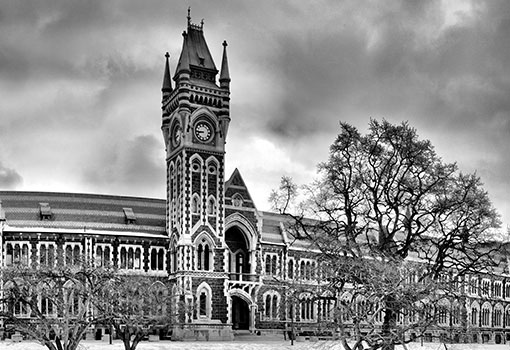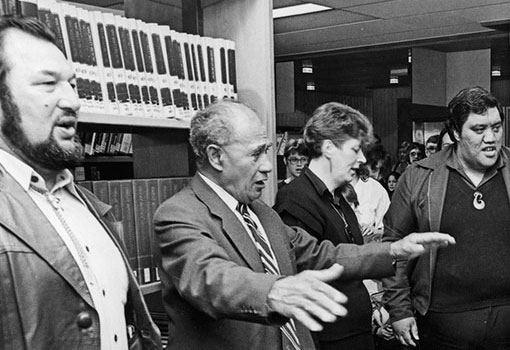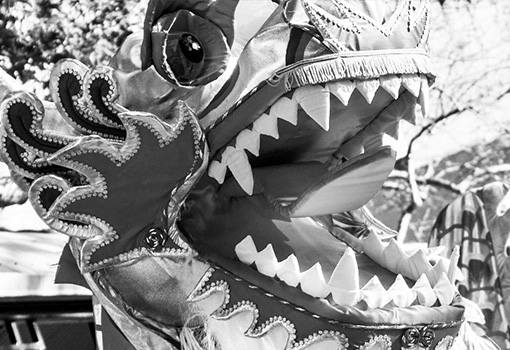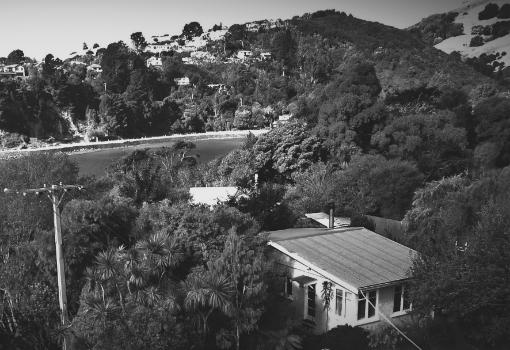Life of an artist
Posted: Tuesday Oct 20, 2020
It is fitting a new book about Ralph Hotere shines light in darkness, sheds light about darkness and reveals the limits of light against darkness. Bruce Munro talks to acclaimed New Zealand writer Vincent O’Sullivan about the joys, insights and frustrations of writing a biographical portrait of his late friend, one of this country’s most significant, yet private, artists.
Down the hallway to the lounge of Vincent O’Sullivan’s tasteful Port Chalmers villa float the soothing sounds of RNZ Concert. Outside, spring blooms bob in a breeze that a minute ago was rustling flax and tussock among the sculptures in the Hotere Garden Oputae, only a few hundred metres from here, overlooking Otago Harbour.
O’Sullivan, one of New Zealand’s best known writers and the country’s poet laureate for three years, shifted south to this settlement in 2012. That same year, Ralph Hotere, hailed as one of Aotearoa’s most significant artists, was made a Member of the Order of New Zealand, the country’s highest honour.
It also marked seven years since Hotere had asked O’Sullivan to start working on his biography.
Unknown to both of them, it was only a year before Hotere would die.
"I liked the pace of life here," O’Sullivan, who grew up in Auckland and worked in Wellington, says.
"Unlike say, Auckland, Dunedin is ‘unsmart’. It is not worried about its image because it knows what it is."
It is something Hotere, who lived here half a century, liked about the place too, he adds.
"When Ralph was living here he didn’t have to pretend to be anything; he was just himself.
"He loathed snobbery and pretentiousness."
Not that O’Sullivan claims to have ever been a close friend of Hotere.
They met as students in London in the 1960s and were in similar circles once back in New Zealand.
"In Auckland, in the ’60s, we used to bump into each other in The Kiwi. Probably the closest thing the city had to what you’d call an intellectual salon was the big public bar at The Kiwi," O’Sullivan says with a laugh.
"That’s where Ralph drank with McCahon, for example. It was a great melting pot for people of all kinds of generally left-wing interests."
The writer would also sometimes see the artist at art exhibition openings.
"Although, Ralph often didn’t go to his own openings. I remember one show, we met in a pub down in Victoria St rather than go to the gallery opening.
"So we were more than acquaintances - it was a congenial friendship - but we weren’t what you’d call intimate friends."
It was a surprise then, when in 2004, O’Sullivan heard Hotere wanted to have a chat next time he was in Dunedin and, at that meeting, asked him to write his biography. O’Sullivan responded that being Pakeha and being an outsider to the art world might disqualify him.
"Ralph replied that what mattered to him was he didn’t want anyone with an agenda. So, in fact, I think my ignorance might have been to my advantage. He realised I wouldn’t be pushing any particular line."
Because they had known each other for years, it did not occur to either man to put their agreement in writing.
Hotere wrote O’Sullivan a note of introduction - This introduces an old friend of many years, who is writing my biography. If he asks for assistance, I would be grateful if you would help him please - and that was that.
What began as O’Sullivan’s admiration for a gifted painter became - through conversations with Hotere, research into his life and work and interviews with several dozen family, friends and colleagues - a much richer insight into the man and the artist: The Dark Is Light Enough, Ralph Hotere, A biographical portrait.
O’Sullivan spoke to several people to whom Hotere had said his first artistic efforts were as a boy drawing with a stick in the sand on the beach at his isolated west coast home, Mitimiti, north of the mouth of Hokianga Harbour.
"And there was a curious pleasure, he said, in that the waves came and took it away."
As a boy, Hotere also liked to ride his horse up and down the beach and see how straight a line he could form with the animal’s hoofprints.
"When you see his art, you realise how important this meticulous attention to detail and angle and spacing was to him."
He regarded painting as his job, the way building might be a carpenter’s job, O’Sullivan says.
"At the same time, he saw being an artist as a significant gift to be given. So you took it seriously. And you took it seriously by getting on with it, not by talking about it."
His life’s purpose was to paint.
"And that is not me interpreting it. Just a few times, he did say he could paint for a thousand years. Primarily, all that mattered to him in a deeply personal way was his painting."
That consuming passion for his art contrasted with his refusal to play the part of an artist in social settings.
"If people didn’t know who he was, it didn’t bother him. He would just say he was a painter.
"I know this for a fact, because the person who became perhaps his closest friend, a Dutch builder, when Ralph first told him he was a painter he replied, ‘there’s a bit of work I might be able to put your way’."
Hotere’s dislike of what he called "art chatter" came out in various ways.
"We were talking about someone who was actually a friend of his, who had written about his painting. Ralph didn’t have a high regard for critics of any kind, which was more a philosophical conviction rather than caring what they said about him. Ralph said, ‘as soon as someone starts talking about a painting, they are talking about themselves’.
"That was quite a shrewd thing to say about critics, I think."
Hotere had first experienced Dunedin when studying at the city’s art school in the early 1950s. After returning to take up a year-long Frances Hodgkins Fellowship in 1969, he never left. Hotere enjoyed the Port community, working with the city’s artists and art galleries and being able to live the life of an artist.
"In the sense that his time could be given to his artistic intentions, combined with very congenial social surroundings."
But the place of his birth was never far from his mind, O’Sullivan discovered.
"Mitimiti was a reality to him. A reality he reconnected with on trips home every year.
"Going back there was perhaps the most important way for him to keep in touch with some of the things he regarded as core values in himself, especially his relationship with his father."
As a boy, Hotere, one of 14 biological children and eight foster children, had what many would now regard as a tough upbringing on a small dairy farm, O’Sullivan says.
"But he was very fortunate in that he also had very impressive, wise parents who were utterly committed to this large family. Generosity was at the heart of it.
"Much of this was in a house without running water or electricity. They depended a lot on fishing and their vegetable gardens."
Influential support for Hotere came from other quarters too.
Gordon Tovey, who during the 1960s established a programme placing Maori art teachers in Northland schools, became Ralph’s patron. Tovey encouraged his art teachers to have confidence in themselves and their traditions in a way no Pakeha before him had done, O’Sullivan says.
"I think Tovey probably was the single most important person in assisting Ralph’s career.
"Ralph was always popular with his fellow teachers, but they were quite frank that Ralph was never too concerned about turning up to class on time or even at all if he wanted to paint that day. Paint or play golf, he took them equally seriously."
Tovey’s tolerance of Hotere’s half-hearted teaching meant that, in addition to confidence gained, the young artist had a growing portfolio of work, which laid the foundation for further steps.
One of those, which also required assistance, was applying for the Association of New Zealand Art Societies’ annual overseas fellowship.
At the interview, the chairman and some others present implied that as a Maori Hotere would be unable to cope with the pressures of London.
Painter Robert Ellis, of Auckland, played a crucial role by arguing for Hotere before it was put to a vote. When the vote went in favour of Hotere, Ellis told O’Sullivan, the chairman broke his pencil and threw it across the room saying, "I suppose you have to have it your way."
"Hotere had the support and confidence of people," O’Sullivan says, "But on the official level there was still a rather condescending attitude ... that they wrapped up to sound like it wasn’t prejudice, which it obviously was."
A few years later, when applying for the Hodgkins fellowship, McCahon gave Hotere a reference stating he was doing something different from anyone else in New Zealand.
"So he obviously caught the eye of people who could significantly help him."
Support also came from the women in Hotere’s life. He was married three times - to Betty Rameka, Cilla McQueen and Mary McFarlane - adopted Cilla’s daughter Andrea, and had several other relationships and friendships of varying lengths and depths.
Women were extremely important to Hotere, O’Sullivan explains. Important in more than just a romantic sense.
"One woman who he was in quite a serious relationship with for six or seven years said to me, ‘Ralph needed a woman between himself and the world’."
O’Sullivan agrees.
"I’ve often thought that to talk about Ralph without women was like talking about a tortoise without a shell. He depended on them in various ways, not just emotionally.
"They were constantly important to him and gave him a great deal that made his life as an artist possible."
Early in his career, Hotere said he did not care for being called a Maori painter. This disconcerted some people. But it was a misunderstanding, O’Sullivan says.
"If you think of the word ‘Maori’ as a noun, he was absolutely that. But he didn’t like it being used as an adjective to describe his work.
"His independence was very important to him. He hated people saying he was influenced, even when he clearly was."
It was tied up with his sense of integrity, O’Sullivan says.
"For him, art was a totally honest expression of one’s self and one’s whole being; one’s place in the world really.
"He didn’t want this limited by an adjective of any kind.
"As he said, people didn’t talk of Charles Brasch as a Jewish poet."
Over time, Hotere became increasingly immersed in the connections and stories of his father’s iwi, Te Aupouri.
"Ralph’s later works - where he is using more Maori language - he was drawing more and more on this, but always through his father.
"Some of his finest works came out of this."
O’Sullivan has invested much research and thinking into the significance of the Te Aupouri world view on Hotere and his work.
"I don’t want to suggest that I understand Ralph and others don’t. But one thing that became very obvious from spending time on this book was that although he didn’t speak much about things Maori or politics - although he did in his art - he was actually a much more passionate man in his thinking than sometimes people realise."
This makes sense when seen in the context of Te Aupouri myths about darkness "and the fact that ‘Te Aupouri’ itself means ‘the cover of smoke’ or ‘the cover of darkness’.
"His deep personal concerns at times, and even his distress, he kept very close to himself and spoke of to very few people."
There was an aesthetic passion for the business of creating public works of art. But there was also a highly private side to his convictions and thoughts, even those expressed in his art.
"A very important thing here is that many people who knew Ralph as I knew him - if I hadn’t gone into all this - knew his reticence.
"He was almost notoriously quiet about private matters."
A case in point was one particular image Hotere used over and over that he had taken from a church in France.
"I remember the day I asked him a couple of times, ‘why is that image important to you?’ And he just didn’t answer.
"Then I asked him another time and he said" - O’Sullivan chuckles at the memory - "almost as if, oh this is so boring, he said, ‘because it bloody looks good!’
"That is as close as you’d get to an explanation. Even though it clearly had another and deeper significance for him.
"The emphasis in Te Aupouri thinking on the darkness of smoke - and they were a tribe known for their reticence, their ability to cover their tracks - it fits perfectly with what we know about Ralph, his personality and his painting."
O’Sullivan gives another example in his book, of a man from Port Chalmers who went fishing with Hotere for 30 years.
"And they never spoke once about art, religion, politics or anything but fishing."
That was most people’s experience of him. But so much more was going on behind the veil.
"What mattered most to him, he had no urge to articulate for other people’s sake. It was too private.
"His daughter, for example, said that sometimes when he was painting late at night, and just listening to music as he painted, he would actually be crying as he painted."
This was something he would never talk about, O’Sullivan says.
"But it was an indication of the emotional depth ... I don’t pretend for a moment to get through that darkness of Te Aupouri to the core of Ralph, but nevertheless you could get a strong idea of much of his thinking and personality through his art and through the occasional thing he did say and through the handful of relationships with the people that did matter most to him."
The darkness of Te Aupouri informed and shaped Hotere’s art in broad and deep ways.
It provided the element he was looking for that would make him utterly distinctive from other New Zealand painters, O’Sullivan says.
"In the year after his first exhibition of Black Paintings he said to one critic that he realised he had cornered ‘black’ as his own.
"From then on everything he did, or almost everything, was devoted to exploring and expanding the possibilities of black as a central feature of his art."
It was commercial savviness, O’Sullivan agrees. But more than that it was precisely the thing that best suited his temperament and his emotional demands.
"In Maori art and mythology, black has so many layers of possibility of meaning. Even when he started using very vivid colour, it was mostly in relationship to the blackness in a way that created a tension in his work."
O’Sullivan has a further insight, derived from reflecting on Hotere’s upbringing in a house and a settlement without electricity.
"So everywhere was black windows, reflections in windows, candles, fires, reflections. I’ve often thought that this surely must in some way have contributed to his interest in black and what you can do with the reflective qualities of blackness.
"The number of his paintings that were window paintings - black windows, windows in Spain - windows were a central motif. And the blackness beyond the window, which is the world beyond one’s own personality."
If there is insight - and surely there is - the picture, however, is incomplete, a darkness remains.
"I was very careful to call it a biographical portrait because a biography suggests something much fuller."
Hotere had already suffered a debilitating stroke when he asked O’Sullivan to be his biographer. That made the project difficult.
"He did get his speech back but it was never easy to talk with him because it was speaking with a very ill man. He would give coherent answers but you were aware all the time that you didn’t want to tire him."
But the introduction to the book, The Dark Is Light Enough, Ralph Hotere, A biographical portrait, strongly suggests there were other obstacles.
"For a number of reasons, what Ralph and I had started was brought gradually to a halt. It became more difficult to have private conversations with him, and then not possible at all," O’Sullivan writes.
Last year, the Otago Daily Times published a report of O’Sullivan’s talk at the Dunedin Writers and Readers Festival. The paper reported that apparently the Hotere Foundation Trust, which Hotere had set up in 2004, would not allow images of Hotere’s work that it held to be used in the biography.
Indeed, no images of his work appear in the book, which is out next month.
Was this one of the difficulties?
"I don’t want to go into this too much, but there was a whole difficult side to the book, and not because of Ralph," is all he will say.
"It got to the point of such frustration in trying to continue with this, seeing the book was now completely out of Ralph’s hands, that ... at that stage I gave up."
A message however, got through to O’Sullivan, conveyed by Hotere’s sisters: "Keep on with the book".
Hotere died on February 24, 2013, aged 81.
It was several years before anything more happened with the draft manuscript.
"Then I thought, well Ralph did ask me to do this; it’s a debt to him in a way. I shouldn’t let the interference of other aspects prevent it all together," O’Sullivan says.
"That’s why I took it up again at the end of last year and gave the book the shape it has now."
O’Sullivan holds in his hands a photograph taken of him and Hotere, by Reg Graham, in 2006. Hotere in a wheelchair, O’Sullivan’s head turned towards the artist. Two older men in dark clothing, side by side, both looking into the middle distance.
"The most important thing that I ended up thinking about Hotere, at the end of the book, was his utter integrity as an artist and as a man," O’Sullivan says.
"I’m not talking about every relationship. But in his decision to dedicate virtually everything to be a painter. It was what mattered to him.
"What would it be like to be Ralph Hotere? The answer is, look at these thousands of works. That’s what it’s like."
- The Dark Is Light Enough, Ralph Hotere, A biographical portrait is out mid-next month.
https://www.odt.co.nz/lifestyle/magazine/life-artist



